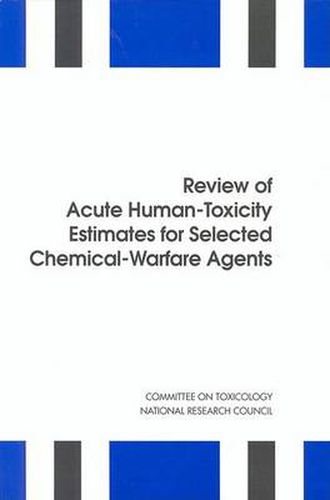Readings Newsletter
Become a Readings Member to make your shopping experience even easier.
Sign in or sign up for free!
You’re not far away from qualifying for FREE standard shipping within Australia
You’ve qualified for FREE standard shipping within Australia
The cart is loading…






No reliable acute-exposure1 standards have been established for the particular purpose of protecting soldiers from toxic exposures to chemical warfare (CW) agents. Some human-toxicity estimates are available for the most common CW agents-organophosphorus nerve agents and vesicants; however, most of those estimates were developed for offensive purposes (that is, to kill or incapacitate the enemy) and were intended to be interim values only. Because of the possibility of a chemical attack by a foreign power, the Army's Office of the Surgeon General asked the Army's Chemical Defense Equipment Process Action Team (CDEPAT) to review the toxicity data for the nerve agents GA (tabun), GB(sarin), GD (soman), GF, and VX, and the vesicant agent sulfur mustard (HD) and to establish a set of exposure limits that would be useful in protecting soldiers from toxic exposures to those agents. This report is an independent review of the CDEPAT report to determine the scientific validity of the proposed estimates.
$9.00 standard shipping within Australia
FREE standard shipping within Australia for orders over $100.00
Express & International shipping calculated at checkout
No reliable acute-exposure1 standards have been established for the particular purpose of protecting soldiers from toxic exposures to chemical warfare (CW) agents. Some human-toxicity estimates are available for the most common CW agents-organophosphorus nerve agents and vesicants; however, most of those estimates were developed for offensive purposes (that is, to kill or incapacitate the enemy) and were intended to be interim values only. Because of the possibility of a chemical attack by a foreign power, the Army's Office of the Surgeon General asked the Army's Chemical Defense Equipment Process Action Team (CDEPAT) to review the toxicity data for the nerve agents GA (tabun), GB(sarin), GD (soman), GF, and VX, and the vesicant agent sulfur mustard (HD) and to establish a set of exposure limits that would be useful in protecting soldiers from toxic exposures to those agents. This report is an independent review of the CDEPAT report to determine the scientific validity of the proposed estimates.